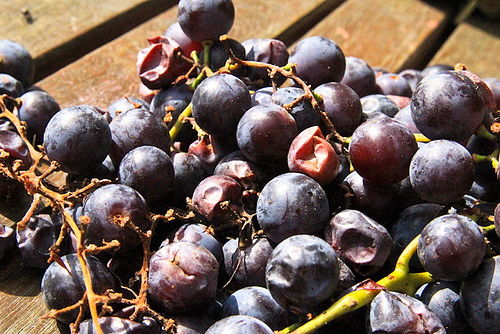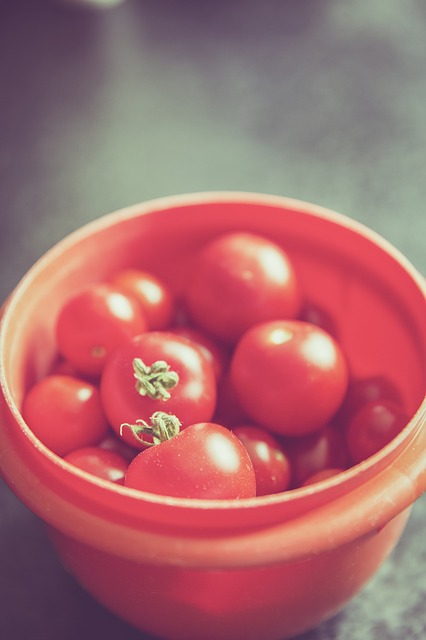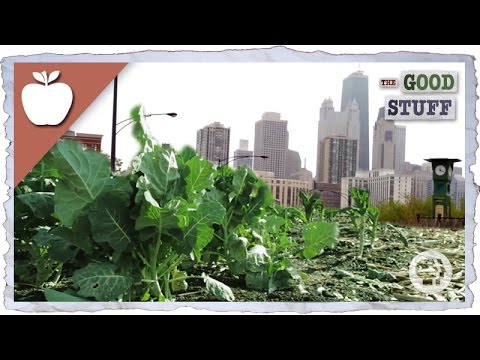If you’ve heard us say it once, you’ve heard us say it a thousand times. At Upcycle, we believe in producing locally. While we have created Native Soil, in part, to help individuals create their own healthy food in their own homes using locally sourced material, deep down, we know this idea is good for the world. Urban Farming is the idea that we can use unused land, roof tops, front yards, balconies, and generally just about any underutilized space to be creating food for inhabitants that isn’t traveling thousands of miles before it reaches the dinner table.
How Native Soil Helps Urban Farming
And that’s where Native Soil comes in. As we know, urban soil is, by in large, terrible. Traffic, aircraft, municipal runoff, pavement, and overdevelopment, just to name a few, have robbed the urban landscape of the necessary nutrients to produce healthy food. At Upcycle, we use locally sourced waste to revitalize that barren soil and make it nutrient rich, so that urban farming can be a locally sourced reality.
We believe that its just the right way to tackle this problem. And, being the nerds we are, we think that PBS has done a great job outlining the importance of urban farming and the techniques that can really make urban farming a viable option for the 21st century and beyond.
A Population Explosion Requires Urban Farming
All the cities of the world contain over half of the population of this world. And do you know how much land that requires to feed that half of that? Half of South America. Half of South America. That’s how much land, when you add it all up the around the world, that’s how much land is put together to feed the cities. OK, so that means the amount of land needed to grow food for the entire world is about the size of South America. Right. And that’s just for crops. The amount of land used for livestock is actually way more than that, about the size of Africa. And the global population is supposed to hit 9 billion in the next 40 years. And that means we’re just going to have to keep using up more and more land. Yep. And keep in mind that 57% of Earth’s land is uninhabitable. And about 3% is developed urban areas.
So we hit 9 billion. That’s a 25% increase. And if we continue to grow our food in the same way– We’re going to run out of space real fast.
Even in a sprawling metropolis like San Diego, urban farming can help reduce the need for population to source food from so far away. Even when food is sourced, what happens to it?
And roughly one third of the food we do produce is wasted. [BLEEP] What would you say is the future of food? Well, the future of food is recognizing what Malthus knew years ago. We eventually are going to run into a food problem. I think we’re already there. So we’re going to have to use possibly future discovered techniques, but definitely we have to use all of the techniques that have worked wonderful for centuries. This is Ken Dunn, president of the Resource Center and founder of City Farm, where they’re reclaiming vacant lots in Chicago and turning them into farms. In the Amazon they learned thousands of years ago to put food waste back on poor soil, and you’ve got rich soil. That’s what we do here. We seal the vacant lot, which has contamination from this being an industrial city. And we put food waste compost two feet deep.
How Much Food Is Wasted Now?
Ken Dunn and the fine people at City Farm create this compost by picking up discarded food from grocery stores and restaurants and other places around the city.
How much food waste is in here? Well, this bin has two ton now. Its capacity is three ton. Giant pile of packaged bagels and gallons of milk. This is just one small example of the waste that happened, what, yesterday? Yeah. And so I get two of these truckloads every day. I have a bigger truck that can haul 15 tons at a load. We get several truckloads of that every week. So you’re going to compost this and use it to enrich the soil. Yeah. Yeah. This is just a fraction of the food waste that happens every day. Grocery stores and food suppliers will often throw out fruits and vegetables that they don’t think can sell based on appearance or quality, even though they might still be edible.
Or in this case, two tons of bagels and milk that were over-purchased by a convention center, and this weird bag of egg and cheese mix thing.
Let’s Take it Back to the Way We Used to Grow


We’ve lost a lot of preservation techniques that people used to know. You know, everybody used to know instinctively how to can things, how to make cheese, etc. And because we’ve given up access to our food system, we’ve lost a lot of those skills. CRAIG: This is David Durstewitz, sales manager at City Farm. So either that needs to be done, you know, more completely on an industrial level, or the more stable solution is just return to a local food system that’s more interconnected. CRAIG: And our food’s often shipped long distances reducing freshness by days and using more fossil fuels. And bringing the farm into the city eliminates those problems. Agriculture is, of course, one of the oldest professions. But it’s not simple. A lot of farming is subsistence, or even losing it. You put in so much labor, you can barely eke out a living. But if you have very rich soil, that tips it in favor of supporting a family and producing good food.
Poor Soil Makes Poor Food
It takes the same amount of time to plant and harvest a tomato in poor soil as it does in good soil.
In poor soil, you get a one-pound tomato. In great soil, rich with compost, you get a two-pound tomato. And its flavor, and thus its nutrition, is excellent. What about the climate? Isn’t a city too dirty to grow crops in? The climate of a city can be beneficial for growing, and it can also be detrimental. Generally, a city is hotter than the surrounding areas.
And so in a northern city that really helps. In Louisiana that might not help. What makes a city hotter? Pollution. CRAIG: Pollution. Well, yeah. Pollution. And just the amount of energy that’s being expended here and then giving off heat. CRAIG: So you’re saying the heat that comes from waste and pollution is useful for growing food. I am saying that, yeah. CRAIG: Well, that’s cool. I’m not advocating– CRAIG: No, I know. Huh. That’s interesting. But realistically, though, how many vacant lots could there be in a developed city like Chicago? The city has mentioned they have 12,000 vacant acres. And they would like them cleaned up, as we have here, and producing jobs with the local neighborhood. But we need to just keep the priorities that a resource should as much as possible be an asset to the local community.
Growing the Right Food or the Wrong Food?
90% of the farms in the United States produce commodity crops that are then converted into processed foods.
And that’s not how to best utilize our space for growing for human health. We need a production system that has as its goal the health of a local community. So local control of a food system is absolutely something that we’ve lost and that we need to regain as quickly as we can for a lot of different reasons. More than one-third of adults and 17% of children in the United States suffer from obesity, while at the same time, 49 million Americans live in food insecure households, either going hungry or lacking proper nutrition.
So at the same time we’re eating too much food, but not enough good food. Right. And part of the solution might be to grow more nutritious food locally to benefit the surrounding community. The resources in the devastated communities of Chicago, a lot of vacant land, a lot of unemployed people, and then a lot of waste.
Where Products Like Native Soil Come In
What if we ingeniously enriched that vacant land with waste wood products, waste food products, and had a rich farm, employed local people to produce the healthy foods that community needs.
[In our case at Upcycle we are using waste from the booming local beer brewing industry, but the concept applies across the board in urban farming. San Diego’s unique waste happens to be beer, but that’s not the case in every city around the world. Urban farming requires a certain level of unique application to apply the local waste as the solution to its own problem!]
Let’s find ways of exploiting the value in a neighborhood for that neighborhood. So this is our model. So maybe if we stop wasting a third of our food to feed those 9 billion people in 2050.
Yeah. Maybe if we start focusing on maximizing our nutrition rather than maximizing our calories we won’t need land the size of South America and Africa for food.
The world is changing fast. If we’re going to keep up with the pace of the changes around us, we’re also going to have to change the way we produce food. MATT: We’re going to have to employ new farming techniques and return to some of the older ones. CRAIG: Maybe we could build up instead of wide, focus more on quality over quantity, keep things local and fresh, maybe even a little lower on the food chain. MATT: There’s not going to be an easy silver bullet solution for upcoming food problems. Every place is different, with their own unique food challenges.
CRAIG: But there’s plenty of improvements that can be made.
Tailoring the SOILution for Urban Farming
And there’s plenty that we can do to help. Living in Chicago, and obviously being surrounded by so many high-rises, I think it’s important to be connected to nature, because it’s something that’s important to me. Are you going to teach me how to plant things? Yeah, we’re going to teach you a few things today. OK. Let’s do it. What’s more important than growing food? Nothing. Nothing’s more important than growing food.
CRAIG: Food is something that a lot of us take for granted. Most of us have only a vague idea of where it comes from or how it’s produced. But our very well-being depends on a healthy, sustainable, and plentiful food supply. So we shouldn’t let it go to waste, because the future of food is the future of us. And done. I farmed.
See ya. So I’m quite hopeful that we will make progress, and civility will return to the planet. So that’s the end of the Future of Food playlist, but hopefully not the end of the future of food. Am I right? Got to fill that belly. Thanks for watching and for all your great comments and questions. If you guys like the show, and you want to help us continue making the show, consider becoming a supporter of patreon, right up there. And we’re always looking for people to help promote the show. So if that sounds like something you’d like to do, sign up for our digital street team.
And if you’re interested in learning more or helping out Ken Dunn in the Resource Center, you can go to resourcecenterchicago.org.
Great Food and Food Waste Reduction go Hand in Hand
I have some exciting upcoming projects to help combat food waste. You should keep a lookout. OK, last week we asked you guys if you thought vertical farms were the future of agriculture. This is what you had to say. Well, they didn’t actually say anything. They typed. Well, they said it with their fingers. You know when you talk, you know, finger talk, into the computer. No, it’s typing, it’s different. Jack Linton so astutely pointed out that mushroom protein can be grown in an urban environment and not use a lot of resources. And they produce CO2, which can be cycled into plant rooms. And Benjamin Shaw thoroughly explained the process of aquaponics, which is basically incorporating fish into the hydroponic plants growth cycle.
Funny story, we already talked about that when we went to a place called The Plant in Chicago, where they do just that. You should check it out. It’s in our Recycling playlist, linked in the doodly-doo. Tyler Cooper, Stephen Gubkin, and a number of you pointed out that vertical farms require a lot of energy and big upfront costs.
It’s true that electric grow-lights cost money and fossil fuels. But by using energy-efficient LEDs, vertical farms can minimize the amount of energy used. A lot of indoor farms use inefficient grow lights that use a lot of electricity and create a lot of heat that were require power-hungry air conditioning units to keep the plants cool.
 LEDs give out very little heat, which means you can have them closer to the plants, you don’t have to pay as much to cool them, and you can have more vertical rows closer together. Also, LEDs can be up to 75% more energy-efficient than conventional fluorescent bulbs. Still comes out to a lot of energy usage compared to sunlight, which is free. But these energy costs could be offset by using renewable energy sources, like the anaerobic digester they have at The Plant, linked in the doodly-doo.
LEDs give out very little heat, which means you can have them closer to the plants, you don’t have to pay as much to cool them, and you can have more vertical rows closer together. Also, LEDs can be up to 75% more energy-efficient than conventional fluorescent bulbs. Still comes out to a lot of energy usage compared to sunlight, which is free. But these energy costs could be offset by using renewable energy sources, like the anaerobic digester they have at The Plant, linked in the doodly-doo.
And as the technology improves over time, you’d expect the energy efficiency to increase as well.
Paul Cristo asked if Green Sense Farms was actually profitable. How much do you make, Paul Cristo? Huh? Huh? None of your business. Well, we weren’t able to get specific numbers. So I guess time will tell. But there’s definitely been a trend in new vertical farms investment and construction, which could be an indication that it’s working.
Vertical Farming and the Urban Farming Revolution
The world’s largest vertical farm is currently being built in Newark, New Jersey. When it’s done, it will grow up to 2 million pounds of kale, arugula, and Romaine lettuce per year. Got to get that Jersey green! Thanks again for all your great comments and questions. We’ll see you guys next week for the first part of our Thrill Seeking playlist. Pretty excited. Thrilling. What’s going to happen? Who knows? Well, we do. We know. We’ve already shot it.
—
With so many people living in such tight quarters, is urban farming the real solution to they myriad of associated problems? Yeah, we think it is. Urban farming uses locally sourced materials to create food locally, thus reducing the double whammy of waste of creation and the waste of transportation. With a little work and a with products like Native Soil, we really do believe that our food can be created locally, even in harsh urban environments through sound urban gardening practices like those outlined in the piece.
We’re in for quite a ride here friends.
